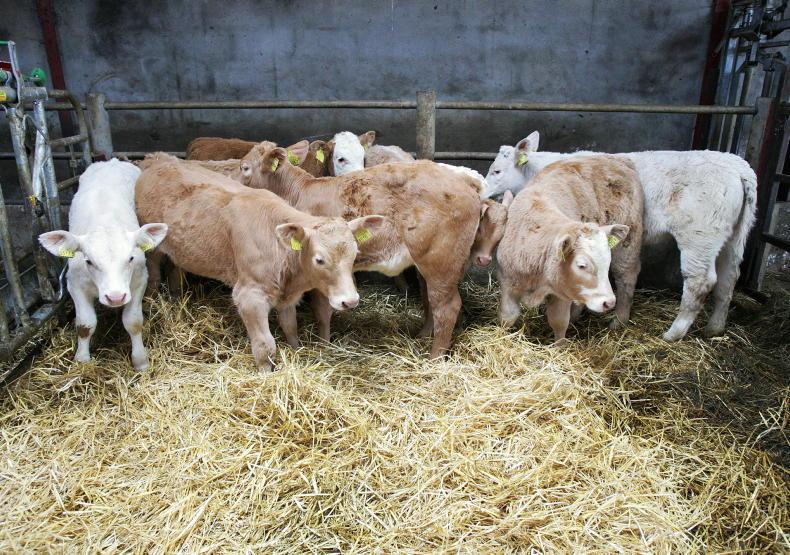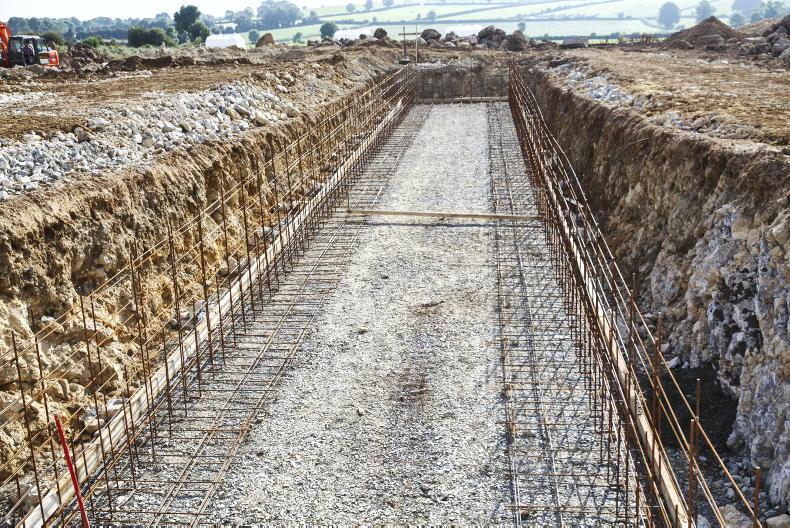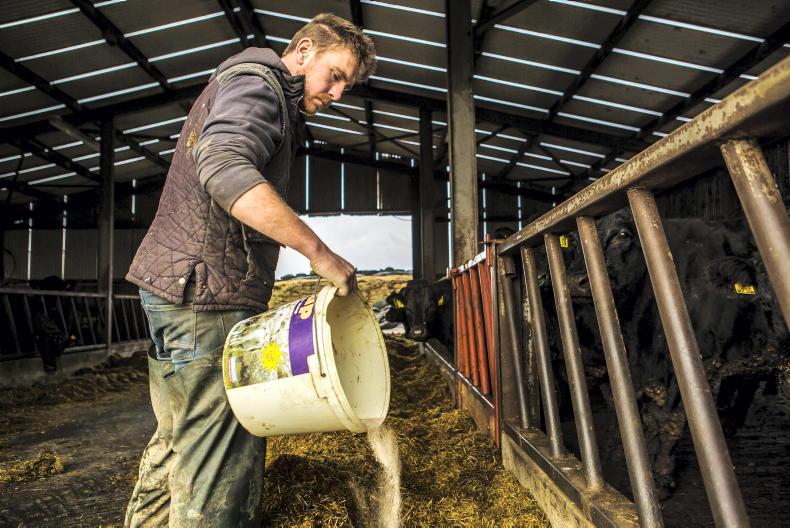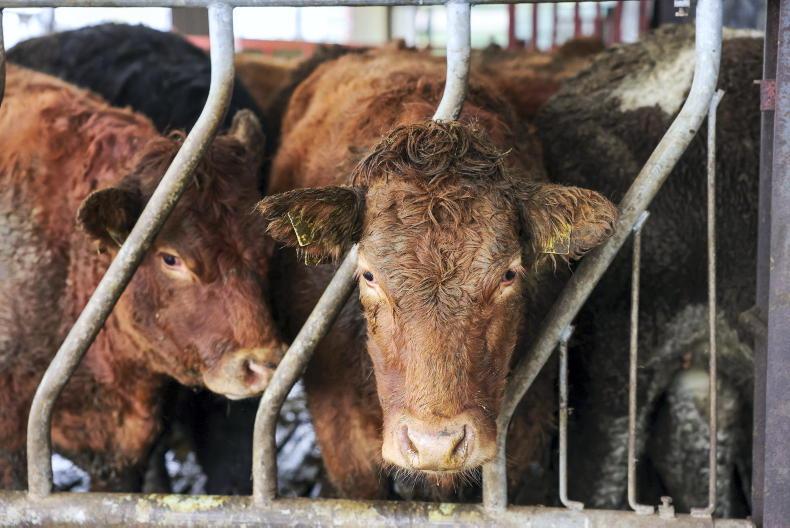On the majority of suckler farms, grazing ground is saturated. Even if weather starts improving over the next fortnight, cows and calves are unlikely to go out to grass until the end of the month, if not early April.
Spring calving is in full swing and with turnout currently not an option for many suckler farmers, shed space will be under pressure, as stocking density increases.
Silage reserves will also be running low, and when combined with limited straw reserves, managing spring-calving cows and their newborn progeny will be challenging until turnout.
To help address these issues, outlined are some tips to manage spring-calving animals until turnout is possible.
When cows calve, demand for energy increases as the animal starts producing milk. Meeting that nutritional demand from a forage-only diet is difficult.
By March, feeding a good-quality forage above 70 DMD may not be an option, so concentrates will be required to meet the cow’s energy demand in early lactation.
If silage is above average quality around 68 to 70 DMD, offer cows 2kg to 2.5kg/day of a 16% ration.
For lower-quality forage, increase meal levels to between 3kg and 3.5kg.
Using body condition
However, if cows are likely to start grazing within the next month, and animals are in good body condition, there is scope to reduce the outlined meal levels by 0.5kg to 1kg/day in March-calving cows.
But there are a few conditions to this.
Firstly, it only applies to mature cows in good condition with a single calf at foot.
Do not include first-calved heifers, thin cows or animals with twins.
Silage needs to be above average quality, or better, to avoid a rapid loss of flesh and metabolic problems.
Reduction in meal
If meal is reduced, cows will convert body fat to energy as a means of supporting milk production in early lactation.
The aim is a gradual loss of body condition over a three- to five-week period.
Provided March-calving cows get to grass by early April, they will regain body condition before breeding starts.
You should provide additional mineral supplementation if reducing meal levels.
Early-calving cows
In contrast, January and early February-calving cows will be close to peak milk yield during March. Some animals will also come back into heat over the coming weeks.
Therefore, it is important that these cows get plenty of energy in their diet, so do not reduce meal levels before turn out.
Stretching straw until turnout
Where farmers are looking to stretch whatever straw bales are on the farm until turnout, outlined are a few tips to keep in mind.
1 Calving pens: calving pens use up a lot of straw. Once cows calve, and you are happy that calves are feeding OK, move them back to group pens as soon as possible.
The longer cows spend in individual pens, the more straw is soiled and bedding will need topping up more often.
Ideally, move cows to a shed with a slatted floor and creep pen for calves.
2 Sheds with split floors: a lot of suckler sheds constructed in recent years have a split floor, with slats behind the feed rail and a straw lieback.
If cows have access to the lieback, can they be penned forward on to slats during the daytime and given access to bedding overnight to save on straw?
3 Calf creeps: do not skimp on straw in creep pens.
Calves will spend 80% of their day lying and a warm, dry bed helps to regulate body temperature, meaning calves burn less energy for heat.
If possible, consider putting pallets down on the floor and then apply straw bedding on top.
The pallets will raise the bed, allowing urine to drain off and keep the bedding drier for longer.
4 Woodchip: woodchip can be used for bedding, but it can be an issue when spreading on land. It needs to rot down, before ploughing into soils. However, it offers great thermal insulation and helps to keep cattle clean. It can be used on its own or as a base with straw applied on top, providing improved drainage and stretching bedding out.
5 Leaking troughs: fix water troughs with a leak as this will keep straw wet, increasing the rate at which it becomes soiled and needing to be topped up.
6 Silage: feeding silage with a high dry matter and fibre will improve dung consistency. Solid dung will reduce the rate straw bedding is soiled.

Providing a dry-bedded creep area will improve calf health until turnout.
Cow and calf management tips
1 Restricting calves to twice daily suckling: restricting calves to suckling in the morning and evening only can ease the pressure on cows in early lactation, helping animals to maintain body condition. There is no negative impact on calf performance and it can improve cow fertility.
Lock calves in the creep pen by day and then allow access to suckle cows for two hours at night. Lock calves in the creep pen overnight, giving access to cows again for two hours in the morning.
2 Clip the cow’s tail: clipping the cow’s tail improves cleanliness around the udder and hindquarter. A dirty udder increases the risk of calves developing scour.
3 Scraping slats: run a hand scraper over slats during the day to keep the lying surface clean. That should improve udder cleanliness and lower the risk of calf scour.
4 Cleaning out sheds: time will be at a premium during spring, but aim to clean out calf creeps and calving pens at least once.
Ideally, aim for midway through the calving period.
Diseases like scour will build the longer housing goes on as well and the more animals move through the calving shed.
Cleaning out sheds at the mid-calving point will lower the amount of disease exposure to calves born in the second half of the calving period.
5 Feeding heifers and thin cows separately: keep first-calving heifers as a separate group to avoid bullying from mature cows in the shed.
Thin cows and animals with twins should also be penned separate from cows in fit condition for targeted feeding.
Read more
Confusion over SCEP stock bull eligibility
Five tips to reducing the risk of calf scour
On the majority of suckler farms, grazing ground is saturated. Even if weather starts improving over the next fortnight, cows and calves are unlikely to go out to grass until the end of the month, if not early April.
Spring calving is in full swing and with turnout currently not an option for many suckler farmers, shed space will be under pressure, as stocking density increases.
Silage reserves will also be running low, and when combined with limited straw reserves, managing spring-calving cows and their newborn progeny will be challenging until turnout.
To help address these issues, outlined are some tips to manage spring-calving animals until turnout is possible.
When cows calve, demand for energy increases as the animal starts producing milk. Meeting that nutritional demand from a forage-only diet is difficult.
By March, feeding a good-quality forage above 70 DMD may not be an option, so concentrates will be required to meet the cow’s energy demand in early lactation.
If silage is above average quality around 68 to 70 DMD, offer cows 2kg to 2.5kg/day of a 16% ration.
For lower-quality forage, increase meal levels to between 3kg and 3.5kg.
Using body condition
However, if cows are likely to start grazing within the next month, and animals are in good body condition, there is scope to reduce the outlined meal levels by 0.5kg to 1kg/day in March-calving cows.
But there are a few conditions to this.
Firstly, it only applies to mature cows in good condition with a single calf at foot.
Do not include first-calved heifers, thin cows or animals with twins.
Silage needs to be above average quality, or better, to avoid a rapid loss of flesh and metabolic problems.
Reduction in meal
If meal is reduced, cows will convert body fat to energy as a means of supporting milk production in early lactation.
The aim is a gradual loss of body condition over a three- to five-week period.
Provided March-calving cows get to grass by early April, they will regain body condition before breeding starts.
You should provide additional mineral supplementation if reducing meal levels.
Early-calving cows
In contrast, January and early February-calving cows will be close to peak milk yield during March. Some animals will also come back into heat over the coming weeks.
Therefore, it is important that these cows get plenty of energy in their diet, so do not reduce meal levels before turn out.
Stretching straw until turnout
Where farmers are looking to stretch whatever straw bales are on the farm until turnout, outlined are a few tips to keep in mind.
1 Calving pens: calving pens use up a lot of straw. Once cows calve, and you are happy that calves are feeding OK, move them back to group pens as soon as possible.
The longer cows spend in individual pens, the more straw is soiled and bedding will need topping up more often.
Ideally, move cows to a shed with a slatted floor and creep pen for calves.
2 Sheds with split floors: a lot of suckler sheds constructed in recent years have a split floor, with slats behind the feed rail and a straw lieback.
If cows have access to the lieback, can they be penned forward on to slats during the daytime and given access to bedding overnight to save on straw?
3 Calf creeps: do not skimp on straw in creep pens.
Calves will spend 80% of their day lying and a warm, dry bed helps to regulate body temperature, meaning calves burn less energy for heat.
If possible, consider putting pallets down on the floor and then apply straw bedding on top.
The pallets will raise the bed, allowing urine to drain off and keep the bedding drier for longer.
4 Woodchip: woodchip can be used for bedding, but it can be an issue when spreading on land. It needs to rot down, before ploughing into soils. However, it offers great thermal insulation and helps to keep cattle clean. It can be used on its own or as a base with straw applied on top, providing improved drainage and stretching bedding out.
5 Leaking troughs: fix water troughs with a leak as this will keep straw wet, increasing the rate at which it becomes soiled and needing to be topped up.
6 Silage: feeding silage with a high dry matter and fibre will improve dung consistency. Solid dung will reduce the rate straw bedding is soiled.

Providing a dry-bedded creep area will improve calf health until turnout.
Cow and calf management tips
1 Restricting calves to twice daily suckling: restricting calves to suckling in the morning and evening only can ease the pressure on cows in early lactation, helping animals to maintain body condition. There is no negative impact on calf performance and it can improve cow fertility.
Lock calves in the creep pen by day and then allow access to suckle cows for two hours at night. Lock calves in the creep pen overnight, giving access to cows again for two hours in the morning.
2 Clip the cow’s tail: clipping the cow’s tail improves cleanliness around the udder and hindquarter. A dirty udder increases the risk of calves developing scour.
3 Scraping slats: run a hand scraper over slats during the day to keep the lying surface clean. That should improve udder cleanliness and lower the risk of calf scour.
4 Cleaning out sheds: time will be at a premium during spring, but aim to clean out calf creeps and calving pens at least once.
Ideally, aim for midway through the calving period.
Diseases like scour will build the longer housing goes on as well and the more animals move through the calving shed.
Cleaning out sheds at the mid-calving point will lower the amount of disease exposure to calves born in the second half of the calving period.
5 Feeding heifers and thin cows separately: keep first-calving heifers as a separate group to avoid bullying from mature cows in the shed.
Thin cows and animals with twins should also be penned separate from cows in fit condition for targeted feeding.
Read more
Confusion over SCEP stock bull eligibility
Five tips to reducing the risk of calf scour











SHARING OPTIONS